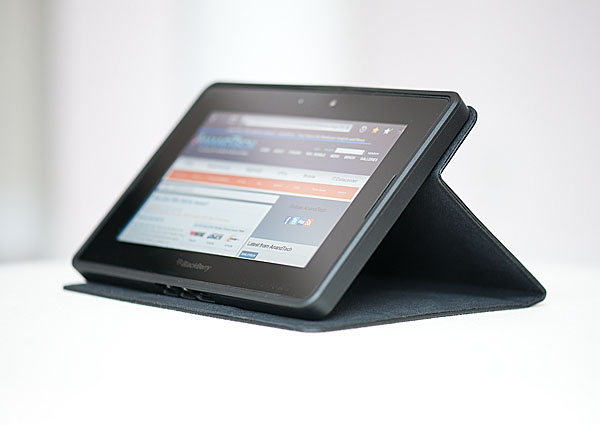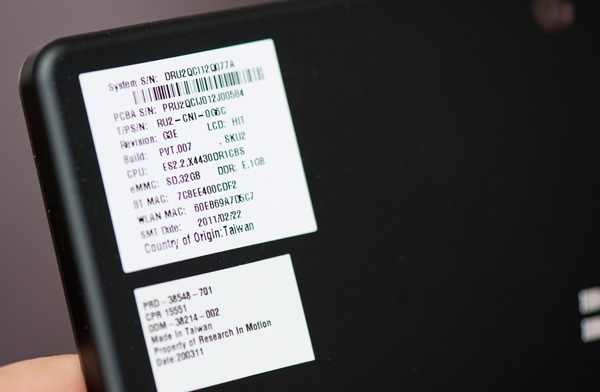The BlackBerry PlayBook Review
by Anand Lal Shimpi on April 13, 2011 9:00 PM EST- Posted in
- Tablets
- Smartphones
- RIM
- BlackBerry
- PlayBook
- Mobile
Final Words
One mistake I believe a lot of members of the press make is assuming that today's two-horse race is representative of the future of this industry. While Apple and Google are clearly out to a substantial lead, there are still more revolutions that will take place between now and when the mobile market finally matures. I'm not saying that Apple or Google won't end up on top, I'm just saying that it's not guaranteed they will either.
If you accept the philosophy that current leaders don't dictate future winners, then the market becomes much more interesting. For starters, it treats everyone as a potential leader. It also lets you focus on the value each player brings to the table, rather than the efforts of one.
The PlayBook is a reasonable experiment for RIM, but I need to see more to really recommend the tablet. We've been burned one too many times by companies serious about this market that have just fallen short on promises to keep things updated (ahem, Microsoft, Palm). RIM is hinting at something new every 6 - 8 weeks, and if that's truly the cadence then we very well might see the PlayBook turn into a significant player by the end of the year.
RIM definitely has the existing market to sell into. In fact, I'd say about the only type of user who should consider a PlayBook on day one is someone who already has a BlackBerry. If you have a BlackBerry and can't give it up but want a better browsing/media playback/consumer experience alongside it, the PlayBook is an excellent path to that. RIM was very smart in its implementation of BlackBerry Bridge. Keep all sensitive data on the BlackBerry, encrypt its connection to the PlayBook, but let you use the PlayBook to bring you what you're missing from the Android/iOS experience without having to carry two phones. Even though you're adding a second device to your mix, the PlayBook at least gives you a larger form factor to work with when you can use it.
It's everyone else that RIM really needs to convince. For your general consumer, the PlayBook is just missing apps (no email, no calendar, no Netflix, no Twitter). Although RIM would have you rely on webmail, I just don't believe that's ideal when both Apple and Google are shipping tablet optimized email clients today. RIM clearly has a plan to address these concerns, I'm just curious to see how long it takes to mature the PlayBook.
Ignoring immediate purchasing decisions, there are some things that RIM has done very right with the PlayBook. Full frame rate playback of 1080p High Profile H.264 content is a huge win. NVIDIA is promising this with Kal-El but RIM and TI deliver it here today. The only thing that's missing is support for .mkv containers and more audio codecs before we can really start putting tablets through our media streamer test suite.
With the exception of BlackBerry Bridge apps, multitasking is ridiculously smooth on the PlayBook. I've never been happy with Apple's multitasking UI and I've been dying for someone to copy webOS since its introduction, so kudos to RIM (and Palm). RIM does have to work on reducing application launch time and providing a consistent 60 fps experience across the OS. The issue with a super smooth UI is that the times when it isn't perfectly smooth really stand out.
I'm glad to see RIM experimenting with form factors. After using the Galaxy Tab 8.9 at CTIA I felt that may be the perfect balance between portability and functionality. The 7-inch PlayBook doesn't do the balance between functionality and portability as well, but it is small enough to actually carry around with me on a semi regular basis.
Battery life could use improvement. I'm not sure if this is an OS thing, battery capacity limitation or SoC problem, but it's real. While I don't normally have to worry about charging my iPad regularly, I do have to worry about charging the PlayBook.
There's a lot to like about the PlayBook, but unless you're an existing BlackBerry user you're better off waiting to see where RIM takes this thing.












77 Comments
View All Comments
Anand Lal Shimpi - Thursday, April 14, 2011 - link
You're very right, clarified! :)Take care,
Anand
Targon - Thursday, April 14, 2011 - link
I will note that the idea of using gestures that originate in the bezel seems to be an evolution of the Palm(now owned by HP) gesture area on the Palm Pre and the other WebOS based smartphones. Yes, the tablet lets you use any bezel, but as I said, this is an evolution of the concept that Palm implemented with the gesture area.Since the HP Touchpad will not have a dedicated gesture area, it will be interesting to see how things play out going forward in the tablet space.
melgross - Thursday, April 14, 2011 - link
But do the gestures really extend into the bezel area, or do they really just start at the first pixel your finger encounters when swiping from beyond the edge of the screen? I think it's the latter. Swiping from the bezel just insures that your finger will be detected hitting that first pixel in the screen at the edge, which tells the OS that it's a special "bezel" gesture.Maybe I'm wrong, but it makes sense to me that that's how it works, then thinking that the entire bezel is gesture enabled with sensors, though it's possible.
Perhaps Anand, can help here.
AnitaPeterson - Thursday, April 14, 2011 - link
Mate, you wrote so many pages, but eschewed some of the most important questions.1) You discuss the screen, but make no mention of the technology - is it IPS? is it TN? As for the surface - is it polycarbonate? is it GorillaGlass?
2) You discuss the USB, but make no mention of crucial use - does the Playbook have USB host capabilities? In other words, can you connect an external HDD to it (whether self-powered or externally powered) and read files from it?
3) Since we mention USB and external storage, how about a peep about SD card support? Seriously... a review with nary a mention of additional/expandable storage?
4) Why are you comparing it with the iPad and the Xoom, instead of comparing it with the only other real, usable device in its size class, namely the Galaxy Tab??? The Playbook is not for people who want large devices, who can get an iPad... Is it not clear that the size is one of the biggest factors at play here? You mention the Galaxy Tab exactly once, and make an intriguing statement that the Playbook is a bit larger... but when it comes to pictures, again you compare it with the Kindle (!??) and the iPad. Eh? the Kindle???
I'm sorry to be harsh, but this is a rush job... just like the Playbook itself.
Lepton87 - Thursday, April 14, 2011 - link
Have you even read the review? It answers two of your three questions. The tablet doesn't have an SD card slot and it doesn't have an USB port either. Your fist question still stands, I'm also curious what panel technology its screen uses.Pessimism - Thursday, April 14, 2011 - link
Incorrect. It does have a USB port, and the review specifically states this when discussing available charging options. The poster was asking whether its possible to use a male-male USB cable to connect mass storage to it.Pessimism - Thursday, April 14, 2011 - link
of hearing everyone whine and complain about lack of matroska support. matroska has NO STANDING outside anime nuts who can't wrap their brains around a second file to contain subtitles. matroska is a tiny speck with no corporate backing, no manufacturer is going to dedicate development time or die space to support it.Penti - Friday, April 15, 2011 - link
Actually it has pretty good manufacturer standing now, it's supported by Sonic Solutions/divx, ArcSoft, CoreCodec and all the serious chipset manufacturers of media player chipsets and STB solutions. As well as support on BD-players and televisions coming along. Nero also has support for it btw. Even boxes like the Roku now supports local playback and MKV. (Roku XDS with USB) Also there is no die space needed it's just a container. Software is all that's needed. Nokia also added MKV support in Symbian^3.DesktopMan - Thursday, April 14, 2011 - link
"As you'll see in our video tests, the PlayBook is the first ARM based tablet we've used that can decode a 1080p H.264 High Profile video stream."I believe the Hard Kernel ODROID-A was the first on the market (though in limited availability), as it's using the Samsung Exynos 4210 SOC. Would be great to see a test of that, to see how well the Exynos drives a tablet. I have high hopes for it.
NCM - Thursday, April 14, 2011 - link
The ability to handle 1080p H.264 is technically impressive, but I have to wonder about its relevance to the intended business market. One might like that at home, although even there it seems to me to be a party trick.And speaking of business use, the idea of using webmail for that is of course a joke, especially on a mobile device that won't always have a live net connection. I'm sure we all understand that this really is a software timing problem, but still, a bit of an embarrassment for RIM.
I'm not enticed by the 7" screen size, which is too big for the pocket and seems too small for good reading functionality. But one of the things we're seeing from the iPad's success is that people are coming up with their own uses for tablets, uses that weren't necessarily envisioned before they hit the market. Maybe that'll happen with the 7" devices too?